“Things are happening at a scale which I could not imagine,” said Andriy Zelinskyy, S.J., during a short visit from the front lines of the war in Ukraine.
Father Zelinskyy made a 28-hour last-minute trip from Kyiv to the Bronx at the invitation of Fordham’s Army ROTC/Military Science Program and the Center on Religion and Culture after the campus Jesuit community helped make the connection. He was told by his commander last Tuesday that he had been granted a four-day leave.
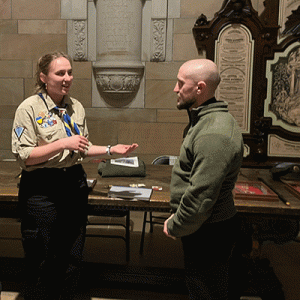
After spending part of the day with cadets from eight colleges and universities who participate in the ROTC program at Fordham, the chaplain spoke to a crowd of more than 200 in the Keating Hall auditorium on March 2. LTC Paul Tanghe, director of the ROTC program and professor of military science, led a one-on-one discussion with the chaplain followed by questions from the audience.
“The greatest surprise for me is that a human being in the 21st century can be so cruel,” he said. “There is no reason for all this violence.” While he believes there is good in everyone, Zelinskyy said acts committed by Russian troops are empirical evidence of the damage caused by a corrupt society where people are so “unfree.”
The atrocities he has witnessed he only alluded to, but he said it is clear to him that Russian soldiers have been so indoctrinated they don’t know how to be human. He cited as an example the bombing of a theater clearly marked as having children inside. “That pilot knew what he was doing. There was no danger. There was no one standing over his shoulder (making him drop the bomb).”
Father Zelinskyy said that while we think of the war as a year old, he has served as a combat chaplain for nine years—since Russia’s invasion of Crimea in 2014, serving unarmed alongside soldiers on the front lines. A chaplain for 17 years in all, he served most of that time as a volunteer while advocating for Parliament to structure a formal role for chaplains in the armed forces. It did so in 2021.
He calls the role of combat chaplain “humble, but a very rich and effective ministry.” He said, “Chaplains have to find a way to share feelings with the soldiers and find sense even in the suffering. Friendship is one of the best ways. For me personally, the greatest reward is when you feel that you can unite people and reinforce them.”
An audience member asked what the rest of us can do to help.
“Don’t give up on the truth. Don’t give up on justice, on what’s really good. Don’t stop contemplating the beauty of the human heart. Stay human. That’s our responsibility,” Father Zelinskyy concluded.
The “Chaplain in Combat” audience included a contingent of 20 U.S. Army chaplains as well as a New York Army National Guard chaplain. Members of the Jesuit community, Fordham Ukrainian Society students, and Fordham College at Rose Hill Dean Maura Mast also attended.
“Fordham is the flagship of the military-connected community in New York City,” said Tanghe. This event was part of a yearlong celebration of the University’s 175-year military legacy.
]]>But there’s more to the war than just missiles and economic sanctions, said Elizabeth Prodromou, Ph.D, a non-resident senior fellow at the Atlantic Council’s Eurasia Center. To fully understand why Vladimir Putin plunged his country into war, Westerners would do well to look at his connections to the Russian Orthodox Church.
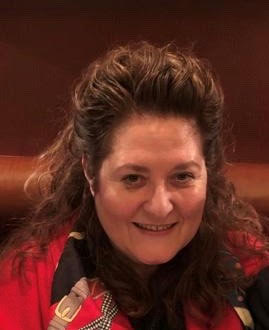
On Nov. 2 at 6 p.m., Prodromou will explore the issue in “Deconstructing Russia’s Ukraine War: Religion, Power, and the Geopolitics of Orthodox Christianity” at Fordham’s Lincoln Center campus. Her talk, the annual Economos Orthodoxy in America Lecture, is presented by Fordham’s Orthodox Christian Studies Center.
“What I want to do is peel away some of those layers and focus on the other features of the war, namely the importance of Ukraine as a space of contestation for Russia, vis-à-vis not only the hard security interests of the transatlantic alliance of NATO, but also the values that the alliance claims to represent,” said Prodromou, who is also faculty director of the Initiative on Religion, Law, and Diplomacy at Tufts University.
“Russia sees Ukraine not only in terms of its territorial importance and its existential security interests but also as a critical religious and cultural space for the protection of and projection of its own values and influence.”
To understand why culture plays as large a role as territory in the war, Prodromou said one need only observe the closeness between Putin and Patriarch Kirill of Moscow, Primate of the Russian Orthodox Church. Unlike the majority of Orthodox Church leaders around the world, Patriarch Kirill has pointedly not criticized the invasion.
“Not only has he refused not to condemn the war, but he has also been supportive of Vladimir Putin’s articulation for the rationale for the war. As a consequence, Patriarch Kirill has been subjected to withering criticism from other Orthodox Churches worldwide, including Bartholomew, the Ecumenical Patriarch of Constantinople,” she said.
“That has produced enormous tension and contestation within the Russian Orthodox church, as well. Not a lot of it is very public, but by virtue of reportage from priests, lay people, and experts in that church, it’s clear there is a grave disagreement within the Moscow Patriarchate about the support for the invasion.”
In her talk, Prodromou said she will explore the relationship the Russian Orthodox church and the Russian government have had going back decades. Although the church was violently suppressed during the Cold War, it initially flourished after the Soviet Union collapsed, having found a supportive partner in the government that followed. Patriarch Kirill’s support of the Ukraine invasion has clouded the picture of the partnership, in ways that Prodromou said echo how bishops in the Roman Catholic Church once allied themselves with autocratic leaders in Central and South America.
“That church/state closeness, in the form of the alliance between Putin and the patriarch, has led to a cynicism among many Russian Orthodox believers,” she said.
“Some speculate whether this is a church-state relationship that has been cemented, or whether it is just a partnership between Putin and Kirill. In a post-Putin and post-Kirill world, what will the relationship between the church and the state look like? That’s hard to predict.”
If there is a positive development to the current situation, it’s that Patriarch Kirill’s endorsement of the war has also thrust Orthodox Christianity in general into a brighter spotlight.
“That has led to a greater inquiry into Orthodox Christianity by scholars, policymakers, and media experts. That’s led to a far more nuanced understanding of the global footprint and the incredible pluralism within Orthodox Christianity” said Prodromou.
“It has moved aside the conventional, essentializing stereotype that all Orthodox Christianity is the same, regardless of local conditions.”
It’s also a good display of the value of “soft power.” In exchange for giving his blessing to the war, she said, Patriarch Kirill has found in Putin an enthusiastic proponent of the social conservatism that he favors.
“There are all these kinds of power in the power toolbox—hard, soft, sharp, smart, and I’ll be exploring these in my lecture,” she said.
“Especially in the 21st century, there’s a whole host of tools of power that can be deployed for influence building and projection of influence, whether by force or other means.”
George Demacopoulos, Ph.D., the co-founding director of the Orthodox Christian Studies Center, said he expects Prodromou’s talk will be enlightening for anyone who cherishes the value of free religious expression that has not been co-opted by politics.
“For years, Dr. Prodromou has been a champion of the twin causes of religious freedom and human rights, particularly in the Middle East,” he said.
“Few have her comprehensive understanding of the lived experience of religious minorities in fraught political situations.”
]]>For Priya Ravindran, who met her Ukrainian husband at Fordham and later adopted his country as her own, reporting on the war and sharing her young family’s story is an act of resistance.
When Russian president Vladimir Putin ordered a full-scale invasion of Ukraine in February, Priya Ravindran was living in Kyiv with her Ukrainian husband and their 2-year-old son, Neil. The couple met in 2010 as graduate students at Fordham and were married in Kyiv four years later.
“We led fairly normal lives. We worked, traveled within Ukraine and internationally, went out on the weekends, went out to eat, met with friends,” said Ravindran, who was an editor at the Ukrainian state-run news station UATV English before going on maternity leave in 2019. “It wasn’t until February 24 that our lives changed forever.”
Two days later, amid reports of military and civilian casualties near Kyiv, they fled, joining more than 12 million people who would leave their homes following the Russian invasion.
‘Trying to Play My Part’
As they drove away, “Alex asked me in the car, ‘Do you realize you are now officially a mother fleeing war with an almost-3-year-old?’” Ravindran wrote on February 26.
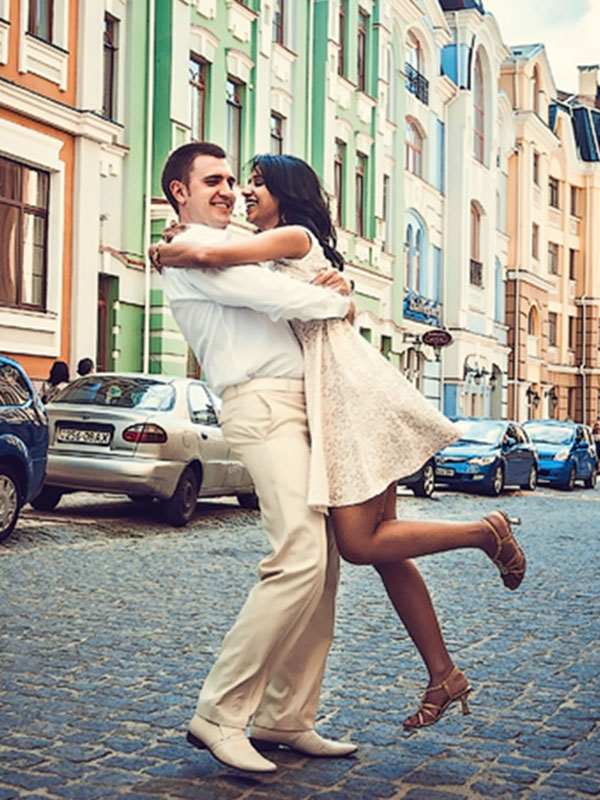
“We always knew this was a possibility. Even before I got pregnant, I asked Alex many times, ‘What if we have a child and full-out war breaks out?’ … Like with everything in life, you try to put those thoughts at the back of your mind, but here we are.”
They headed west with a friend and his mom, driving through numerous Ukrainian military checkpoints. “We are surrounded by the Carpathian Mountains, vast snow-covered fields, and heaps and heaps of trees with just the perfect amount of snow,” she wrote. “Seeing the pristine beauty of nature, I almost think to myself, ‘This is all a dream, right? It has to be.’ But no, this isn’t a dream. … Ukraine is still fighting for its existence.”
On February 28, they arrived at their destination: a friend’s home in Ivano-Frankivsk.
“I have a lot of guilt that I’m not doing enough, not helping enough,” Ravindran wrote that day. “But I’m trying to play my part in letting people know what’s happening, as best as I can, in the best way I know how: through my love of writing.”
Since late February, Ravindran has been posting daily accounts of the war. In each post on her public Facebook page, she typically mixes news and analysis with a firsthand account by another writer as well as personal stories of her family’s experiences and emotions. (To protect her husband’s identity, she uses the pseudonym Alex to refer to him.)
Her posts have reached a broad audience. On March 3, one day before Neil’s third birthday, she was interviewed by Indian TV journalist Barkha Dutt, “whose reporting in the 1990s on the India-Pakistan war convinced me as a 12-year-old to be a journalist,” Ravindran wrote.
From Mumbai to Kyiv via Rose Hill
Born in Mumbai, Ravindran was 17 years old when she moved from India to the U.S. to attend college. After earning a bachelor’s degree in journalism and international relations at the State University of New York at Oswego, she enrolled at Fordham to pursue a master’s degree in political science.

The day before her classes started in fall 2010, she left her walk-up apartment on Arthur Avenue to buy groceries. “When I returned, I was holding the door to the building open with one leg while pushing all my bags in,” she said. “At the same time, Alex exited his apartment on the first floor, stopped, and asked me if I needed help. I told him I could manage, but he insisted, so he carried all my bags upstairs and started to run away. I screamed ‘Priya!’ after him, and he said, ‘Alex!’”
Alex had arrived at Fordham on a Fulbright Fellowship, and he was enrolled in Fordham’s International Political Economy and Development program. The two saw each other in class the next day, Ravindran said, but it wasn’t until the end of the semester that she learned that they share a love of trance music. “I invited him and his roommates to a concert by a famous German duo,” she said. “He asked me out the next day, and the rest is history, as they say.” They were married in Kyiv on June 26, 2014.
A Rousing Song for the Motherland
In her daily posts on Facebook, Ravindran has covered numerous aspects of the war. In early July, she published transcripts of phone conversations intercepted by the Ukrainian Security Service in which Russian soldiers discuss the killing of civilians. In mid-May, she shared the results of a Kyiv School of Economics study indicating that, as of May 10, the war had caused an estimated $600 billion in economic losses in the country. And in June, she covered a nightly address by Ukrainian president Volodymyr Zelenskyy in which he said that at least 828 children had been affected by the war—446 injured, 243 killed, and 139 missing.
“We talk about war and its impact in numbers, and as jarring as they may be,” Ravindran wrote, “they don’t always convey the full story. … They don’t tell us about the trauma parents and their children are dealing with. We remember so many wars in numbers, but we forget about the stories.”
Amid the fear and anxiety of the war, and the near-constant threat of air raids, she has found moments to celebrate: the “happiness on Neil’s face” when he gets a couple of “siren-free” hours to play in a local park, for example, and the “immense joy” of seeing the Ukrainian rap and folk band Kalush Orchestra win the annual Eurovision Song Contest in mid-May.
“It doesn’t mean anything for the war,” she wrote at the time, “but it was a small relief for the psyche.” She noted that the band’s lead singer, Oleh Psiuk, wrote the winning song, “Stefania,” as an ode to his own mother. But since the Russian invasion, the song has taken on new meaning.
“People have been using the song to symbolize Ukraine—the yearning of children who have been separated from their mothers because they are serving in the military; the emotions of sons who are missing their mothers who crossed the border to bring their other siblings to safety; the pain of children who have lost their mothers to the war,” Ravindran wrote.
And with lyrics like, “I’ll always find my way home, even if all roads are destroyed,” she added: “Some are reminded of the motherland itself.”
Read Priya Ravindran’s Ukraine war journal on Facebook at @pravindran1.
]]>“I came immediately when the war started and ended up right in the middle of mayhem in eastern Ukraine very quickly,” he said.
In recent months, his pictures have been published in The Wall Street Journal, The Atlantic, and other publications. He was among the first to document the mass killings of unarmed civilians in Bucha. In April, he photographed the country’s embattled leader, Volodymyr Zelenskyy, at the presidential compound in the capital, Kyiv. And in June, he spent time with soldiers near the front line in the Donbas. One of his pictures—of a young woman rescuing dogs from a shelter in Irpin amid Russian attack in the early days of the war—has taken on a life of its own as a symbol of Ukrainian resistance.
It’s the kind of work that Occhicone has wanted to do since he was an undergraduate at Fordham in the early 1990s, when a friend and fellow classmate of Croatian descent showed him magazine stories depicting war in the former Yugoslavia. “I remember the pictures, I remember who took them, and it became a kind of goal of mine” to become a war photographer, Occhicone said by phone from Kyiv in early March.
Another inspiration, he said, was his grandfather, a World War II veteran who lived in the Belmont neighborhood of the Bronx, near Fordham’s Rose Hill campus. “The family dream was always to go to Fordham,” Occhicone said. “That was like success, you know? He came from Italy, and seeing the Fordham guys, [he thought], one day, somebody in our family will go there.” Occhicone’s grandfather died in 2017 at 101.
“He talked about [his war experiences] until maybe his last day, and it was always about the comradeship and the bonding,” Occhicone said. “That’s something I wanted to understand.”

Evacuating Civilians Amid the Battle of Irpin
On Saturday, March 5, as Russian forces surrounded Kyiv on all sides but the south, Occhicone joined a convoy of volunteers who arranged to help evacuate several dozen people hiding in a church basement in Irpin, a city about a dozen miles northwest of Kyiv. To help slow the Russian advance, Ukrainian forces had blown up a bridge over the Irpin River, one of the main routes leading out of the city toward Kyiv.
“We were deep in the city [bringing people out], and in the middle of it, we started getting shelled—small arms fire flying overhead, tanks shooting buildings maybe 200 meters away,” Occhicone said the next day. “We were able to get out, but right in front of us, maybe like a couple of hundred feet, guys blew up a Russian vehicle, a road was closed. It was just chaotic. You don’t know who’s where.”

Occhicone returned to the city to photograph and assist with successive waves of evacuations near the battered bridge.
“I don’t know who said war is hell, but it is hell, and you’ve got to document it,” he said on March 17, describing the fear experienced by civilians leaving homes burned to the ground, carrying a “plastic bag with some shoes” in it.
By the end of March, Irpin was “an abandoned ghost town of ruined buildings,” Reuters reported, but Ukrainian forces had recaptured the city and helped prevent a siege of Kyiv.



President Volodymyr Zelenskyy for The Atlantic. He
accompanied the magazine’s editor in chief, Jeffrey
Goldberg, and Anne Applebaum, who interviewed
Zelenskyy at his compound in Kyiv: “Ukraine can win—
and by ‘win,’ he means continue to exist as a sovereign,
if permanently besieged, state—only if its allies in
Washington and across Europe move with alacrity to
sufficiently arm the country,” they wrote.
In Bucha, Helping a Son Find and Bury His Father
In early April, Occhicone was one of the first photojournalists to arrive in Bucha, about 20 miles northwest of Kyiv, after it was liberated. “When we entered the city, we saw [people] putting the Ukrainian flag up at the city hall,” he said. He also saw and documented graphic evidence of war crimes.
Retreating Russian soldiers had left behind dozens of dead civilians, some with their hands tied—atrocities that prompted U.S. President Joe Biden to describe Russia’s war in Ukraine as genocide. In an auto repair shop in an industrial part of town, Occhicone photographed the body of a man in work clothes with a gunshot wound to his head. He apparently had been executed and left in a well in the garage.
“At the time, I didn’t know who he was. I just assumed he was a mechanic,” Occhicone said, “and my father’s an auto mechanic by trade—he owned a gas station, real estate, and other stuff, but that’s how he started out. So I see this older man executed in what I thought was his place of business, and that’s probably the one that affected me the most.”
About two weeks later, a Bucha city councilwoman contacted Occhicone. She had been collecting pictures of the atrocities from journalists and others in an effort to help residents locate missing family members, she said, and a young man had seen the picture of the man in the garage and recognized the body as his father’s. She asked if Occhicone would like to meet the family at the morgue in Kyiv in the morning.
Although he was in Romania, taking his first brief vacation in many months, he made the 12-hour drive to meet the family. At the morgue, he learned that the man, Myron Zvarychuk, was not a mechanic but a Ukrainian Orthodox priest. He had been associated with St. Michael’s Golden-Domed Monastery in Kyiv, and he was working at a small church in Bucha, where he had been renting a room from an older woman named Kateryna. On the day he disappeared, he had left to get food and water for her.


From the morgue, Occhicone accompanied the family to Father Zvarychuk’s room in Bucha, where they picked up the priest’s vestments. After returning to Kyiv to collect the body, they traveled to his native village, near Ivano-Frankivsk in western Ukraine, and Occhicone spent several hours at the family’s home before attending the funeral Mass and burial.
“To be able to meet the family and spend a day with them was really an incredible experience,” Occhicone said. “You normally don’t get to follow up on these things. You’re in a situation where there’s dead bodies all over the place, and it feels very surreal. But to be able to put a name to the man, to know something about him, to meet his family was really a great thing, you know. This guy was a loved person. People loved the village priest.”

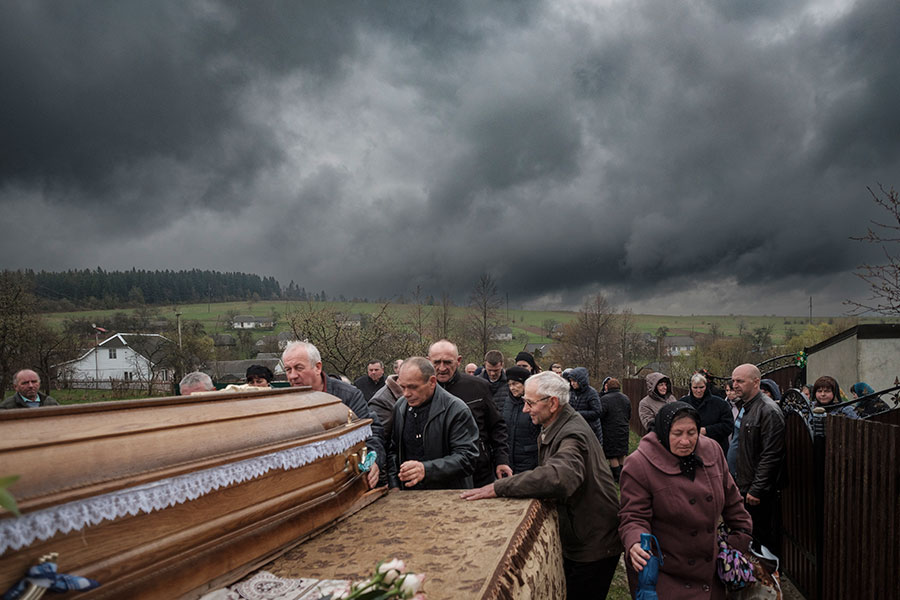
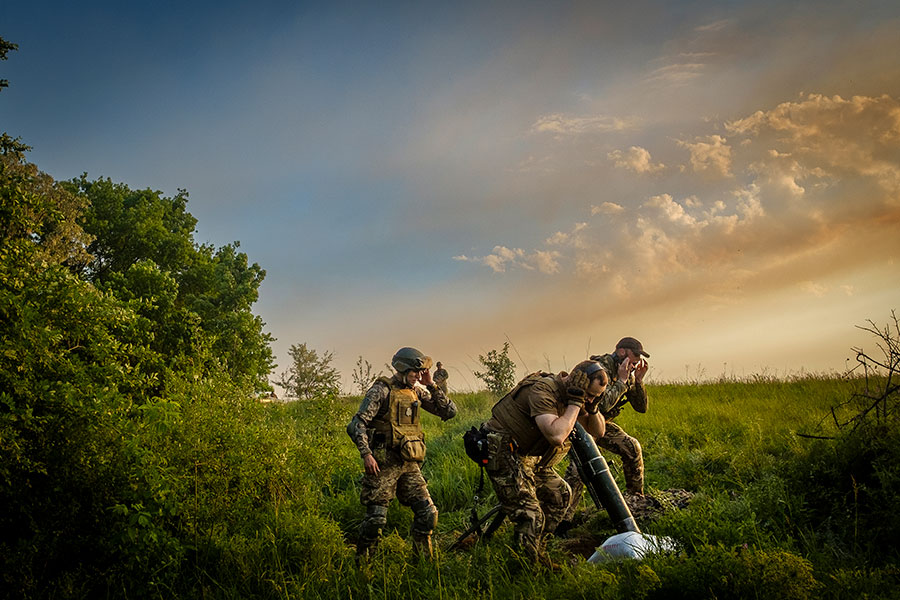
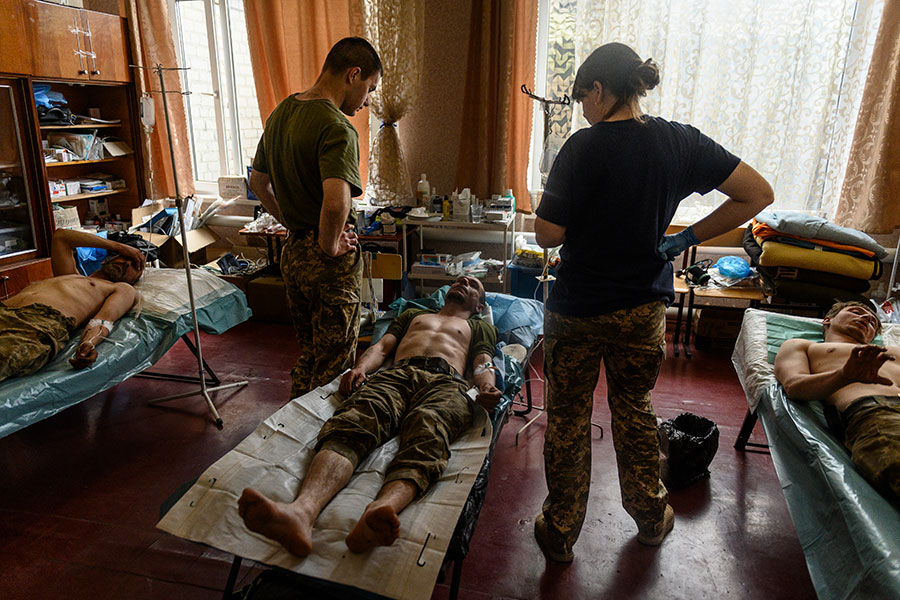
Capturing the Spirit of the Resistance
On March 10, while returning to Irpin to document the humanitarian evacuation of the city that was later retaken by Ukrainian forces, Occhicone made what has become his most iconic and widely seen picture of the war.
“In this atmosphere of fear,” he wrote on Instagram that day, “a woman emerges and she is bringing disabled dogs from a shelter to safety.”
He went to sleep after posting the picture, and “the next day, people were like, ‘The president just reposted you.’” He said the image was featured on the country’s official website, and it brought attention to the young woman, Anastasiya Tikha, a veterinary student who runs an animal shelter in Iprin. He allowed the image to be used by a dog food company that sought to raise money for people in Ukraine, he said, and with Tikha’s permission, he provided her bank account information to dozens of people who wanted to send her donations.
“People are making posters and memes of the image,” he said, “and sending me drawings of the photo from all around the world.” For many people, the image has come to symbolize “the cruelty of the Russian war and the dignity of the Ukrainian response,” The Guardian wrote in a May 23 article about Tikha.
“She’s a woman of action, and people love that,” Occhicone said. “And it’s dangerous. This is exactly where [U.S. journalist and filmmaker] Brent Renaud was killed [on March 13], and this girl took all the dogs out of the kennel and just walked them out of town.”

About Christopher Occhicone
After earning a bachelor’s degree in history from Fordham in 1995, Occhicone worked as a teacher in Poland and Italy, and pursued graduate studies in public health at Harvard University and conflict resolution at Seton Hall University. In 2014, he completed the one-year program in documentary practice and visual journalism at the International Center of Photography in New York City.

Kim Bepler, a Fordham trustee fellow, is providing a dollar-for-dollar match for all donations to the new Fordham Ukraine Crisis Student Support Fund, up to $50,000. The fund will be used for essential needs such as meals, housing, emergency health care, travel funding, tuition assistance, and more.
It is meant to help roughly a dozen Fordham students from the two countries whose finances, and lives, may have been disrupted because of the conflict. A few of those students have already sought help from the University, and more are expected to do so.
Bepler said she offered the funding as a way to help Fordham students who have lost not only their funding sources but also their sense of certainty and stability.
“I feel strongly about the situation, especially [because of]the students and how vulnerable they must feel when they have no access to their family and they don’t know what’s going to happen to them next,” she said. “It’s not fair.”
The war has caused anguish and a sense of helplessness for some Fordham students who have family members in Ukraine who are caught up in the conflict. It has prompted rallies and discussions in the University community, as well as a fellowship program cosponsored by Fordham’s Center for Jewish Studies to help Ukrainian scholars carry on with their work, despite the conflict.
The Russian invasion has caused $565 billion in economic losses in Ukraine, one of its government ministers said on March 28, and more than 4 million refugees have fled Ukraine since the start of the invasion, according to the United Nations High Commissioner for Refugees.
Russian students are vulnerable too, as financial freezes in response to the Russian invasion can keep Russian families from supporting their students in the U.S. These young people may also be impacted emotionally by the backlash that Russians around the world are facing due to Putin’s actions. Bepler expressed hope that Russian students would not feel burdened or isolated by an action begun by the Russian president.
“This is symbolic of defending democracy against a madman,” she said. “In response to the madman, we’re going with magis,” she said, referring to the Jesuit concept of always seeking more opportunities to help others.
“If my small gesture helps one student do one simple thing much easier, and with less pain,” she said, “I feel very blessed.”
Donate to the Fordham Ukraine Crisis Student Support Fund.
To apply for assistance from this fund, please contact Brian Ghanoo, assistant vice president, Office of Student Financial Services, at 718-817-3811 or [email protected].
]]>